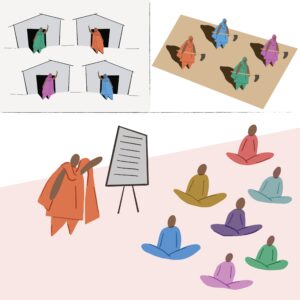This document is part of a series of guides for planning and leading co-design workshops in your community. It is a work in progress and needs your input and feedback to make it more helpful and effective! We look forward to working with you to improve this guide, or to having you take it away and make it your own in whatever way you find most useful. You may wish to follow all or part of the suggestions, or to make modifications depending on what is most appropriate for your context and goals.
Why Co-design?
Co-design is a process that actively engages those who will be most impacted by a design from the earliest stages of planning and creating. Participants, often those whose needs are least served by existing designs, are involved as designers engaged in active and sustained collaboration.
Co-design supports the direct engagement of workers within your organization in important decision-making processes. Through co-design, workers are involved in the creation of designs that meet their needs.
Community-led co-design is an approach in which the entire co-design process is developed in collaboration with community members. It engages existing leadership within the community during the co-design planning stages, by identifying and collaborating with members who will take on the role of leading the co-design sessions.
Your role in leading a co-design workshop
Your familiarity with the context and culture in which your community and the worker-members of your organisation live and work is the expertise most needed to lead a successful co-design workshop. You don’t need to have the answers or the solutions; this will come from the participants during the co-design process.
As part of the community, you know best how to frame and communicate ideas to community members, and you are the best person to accurately interpret ideas expressed by community members. As a community leader, you are an expert in how best to motivate and engage with community members. This expertise, combined with some careful planning, will provide you with everything you need to ensure a successful co-design process.

Where to begin
A good starting place for co-design is to clearly identify the topic or the issue that you wish to explore with your community. You don’t need to have the problem fully defined or understood before beginning. This will often become clearer as you work with community members, who themselves will identify the issues in more detail in the early stages of your co-design process. Understanding the importance of the issue and how co-design can help to address it will help to motivate and guide you through the process.
Taking a step back
Before engaging in a co-design process, it is important to reflect on whether or not this is the right time for it. Is the community you are planning to work with at a stage where coming together to solve a problem is realistic and appropriate? There may be other steps that need to be taken or supports that need to be in place first that will create the conditions in which co-design is viable. What skills, knowledge, or tools will community members need in order to participate effectively?
What skills, knowledge, or tools will community members need in order to participate effectively?
It may be most appropriate to engage community leaders in a co-design process first, such that they can build capacity to lead co-design in the future. In some cases, community leaders may have a shared understanding with the community that they represent members’ interests and can speak for their needs; in many cases they themselves are community members who have emerged as natural leaders. In these cases it may be appropriate to engage in a co-design process with community leaders only.
It may help to reflect on the following questions before embarking on a co-design process:
- Is co-design what is needed right now?
- What skills, knowledge, or tools might community members need to have first in order to participate effectively?
- For example, before women farmers in India participate in co-design workshops about data governance, it may be important that they first learn about the role and importance of data in their work. For example, learning about the process of soil sampling and soil quality testing, and how that data can be used to improve their work processes and that of their community.
- What capacity-building activities need to take place before co-design can be effective?
- For example, taking a “train the trainers” approach at SEWA in which community leaders first learn how to lead co-design by engaging in a co-design process themselves.
- What skills, knowledge, or tools might community members need to have first in order to participate effectively?
- Are you the right person(s) to be leading the co-design process?
- Consider others who may not be in “official” leadership roles but who may have something to offer in terms of leadership or facilitation
- This leadership may emerge during the co-design workshops so it is important to stay aware and flexible enough during the process to make space for it.
- Consider others who may not be in “official” leadership roles but who may have something to offer in terms of leadership or facilitation
Contribute
Technology and social justice are complex topics that require a diversity of perspectives and contributions. Join the conversation by sharing your thoughts, questions, critiques, and relevant resources with us at info@datacommunities.ca.